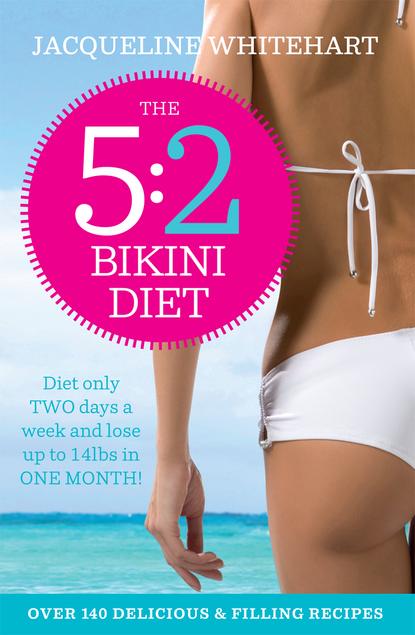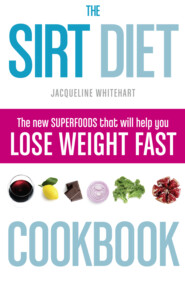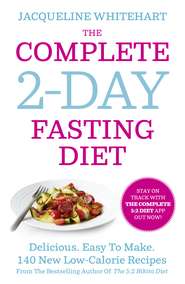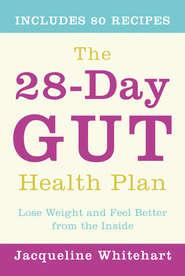По всем вопросам обращайтесь на: info@litportal.ru
(©) 2003-2024.
✖
The 5:2 Bikini Diet: Over 140 Delicious Recipes That Will Help You Lose Weight, Fast! Includes Weekly Exercise Plan and Calorie Counter
Автор
Год написания книги
2018
Настройки чтения
Размер шрифта
Высота строк
Поля
Intermittent fasting (IF)
Intermittent fasting is a coverall term for any type of fasting diet. So the 5:2 diet, the fast diet, the 2-day diet and ADF all come under the umbrella of intermittent fasting.
The advantages of 5:2/fast diet over other forms of intermittent fasting
There is a reason why more people follow the 5:2 diet than any other form of IF – you are more likely to have success because it’s easier to stick to and simpler to fit into your lifestyle. The dropout rate is lower than other types of IF and, indeed, than other types of diet. Put simply, the 5:2 diet is the simplest and most sustainable fast diet.
Possible dangers and side effects of the 5:2 diet
Because this diet is a fairly radical approach to weight loss, it is wise to speak to your doctor first to see if it is safe to follow the diet.
Current medical opinion suggests that the benefits of fasting are unproven. This is because long-term studies take several years, or even decades, to complete and this is a relatively new field.
The good news is that no significant dangers or problems with the diet have been reported so far. We can also take note that certain religions have been fasting for hundreds of years. Fasting during Ramadan requires Muslims to fast during daylight hours for a month. Fasting is also common among most Hindus. They fast on certain days of the week based on their belief and to appease certain deities. Both Hindus and Muslims believe that fasting is important for the wellbeing of human beings as it nourishes both physical and spiritual needs.
What about side effects?
As with all big changes to your normal diet and routine, there can be side effects. Some people will not experience any side effects, but a few will find the side effects to be so uncomfortable that they will be unable to continue with the diet.
Some of the side effects seem to occur only when fasting is first attempted. These effects, such as headaches and dizziness, will diminish and hopefully disappear altogether over a period of several weeks.
Dehydration seems to be a common side effect of following the fasting diet that doesn’t fade in time. It is easily dealt with by sipping plenty of water or other low-calorie drinks regularly throughout the fasting day.
What about irritability? Yes, some of us do get grumpy when we are feeling hungry. This does seem to reduce as we get used to fasting. But I can get grumpy on fast days and normal days too!
Some people report difficulties sleeping due to hunger and daytime sleepiness. This is less common than other symptoms. Most people feel a buzz of energy during their fasting days. Difficulties sleeping can occur, particularly if you eat the majority of your calories during the early part of the day. Increasing the size of the evening meal and making sure it is rich in complex, filling carbohydrates helps the body feel sustained until after we go to sleep.
Finally, here’s one side effect that has affected me. I’ve been feeling the cold all through the winter, but particularly on fasting days. It has been a rather cold winter this year, but I have been suffering more than I would expect. The result has been an increased wearing of jumpers – perhaps two or three at a time and a higher heating bill. I take comfort in the fact that this is likely to mean that my body fat is reduced and the diet is working well.
Fasting and hypoglycaemia
If you suffer from, or might be suffering from, hypoglycaemia as a medical condition consult your doctor before beginning the diet.
The feeling of low blood sugar when you haven’t eaten for a few hours is a common problem and one which I have suffered from in the past. It may put someone off fasting, because they feel that they need to eat every couple of hours to keep their blood sugar stable. The basic problem is that if you don’t eat every three or four hours then you can become hypoglycaemic and therefore irritable, moody, light-headed and shaky.
This is an interesting phenomenon as only a small proportion of the population actually have a malfunction in their ability to regulate blood sugar levels. The rest of us, who do not have an underlying medical condition, do not have to worry about getting ‘low blood sugar’ while fasting. This is because the body is amazingly effective at regulating the sugar flowing around the blood.
A study in which young adults who have symptoms of hypoglycaemia went on a monitored 24-hour fast found that, while they reported ‘feeling hypoglycaemic, their blood sugar levels remained normal. What to do if you are worried about having a ‘blood sugar crash’ during a fast period? This is a very real problem that I myself suffered from when I started the diet. I now know that my blood sugar levels are fine; I am in fact just exceptionally hungry. Here are my tips that helped me get through it, which I hope will help you too.
• Eat regularly during your fast day – this means three small meals.
• If you feel a wave of light-headedness coming over you, know that it will in all likelihood pass and you will feel normal again in 15 minutes.
• Finally, if it affects your ability to function normally or gives you a headache then you should eat something – nothing that big, ideally 100 calories or so of something filling, a slice of toast or a small banana, for example. Allow yourself those extra calories for that day, but carry on with the fast day if possible.
Don’t let it put you off your next fast day, which will probably be easier. On your next fast day, see if you can last longer without feeling poorly.
When not to fast?
There are certain medical conditions that would make fasting inadvisable or even dangerous, even in this more restrained form. Don’t attempt fasting if you are diabetic or pre-diabetic without seeking medical advice first. It is also not suitable if you are pregnant, breastfeeding or under 18 years old. If you are in any doubt, you must see your doctor first to discuss your options for dieting.
Those who are lucky enough to have good health and for whom fasting is a sensible diet option should also consider that there are some days that prove difficult for fasting.
If you’re already a 5:2er, you will already know that some fast days will breeze by while others will be hard. There have been a few times where I have chosen not to fast or given up on a fasting day halfway through. I don’t feel bad about this because I made the choice for the good of my short-term health and restarted the diet as soon as I felt better. Some of the things that have caused me to consider whether I should be fasting that day include a cold (it’s hard to fast when you have a bad cold, so my advice is: don’t fast), when I’ve had little or no sleep and possibly, for women only, at certain times of your monthly cycle.
Want to find out more about the health benefits?
Here are the studies referenced in this section. Be warned, most of it is not light reading, but it’s a very exciting field and could be worth the effort. Finally, this list is not exhaustive. This is because research in this field is booming and there are new studies coming out all the time. Look out for breaking news stories, which I believe will show more proof and more reasons to fast.
1 Parrella E., et al. ‘Protein restriction cycles reduce IGF-1 and phosphorylated Tau, and improve behavioral performance in an Alzheimer’s disease mouse model’,
http://www.scribd.com/doc/126262180/Longo-Cohen-Paper (http://www.scribd.com/doc/126262180/Longo-Cohen-Paper).
2 Mattson M., et al. ‘When a little poison is good for you’, New Scientist, 6 August 2008,
http://www.newscientist.com/article/mg19926681.700-when-a-little-poison-is-good-for-you.html (http://www.newscientist.com/article/mg19926681.700-when-a-little-poison-is-good-for-you.html).
3 Varady K., et al. ‘Alternate day fasting (ADF) with a high-fat diet produces similar weight loss and cardio-protection as ADF with a low-fat diet Metabolism’, pp137–143, January 2013.
4 Alken J., et al. ‘Effect of fasting on young adults who have symptoms of hypoglycaemia in the absence of frequent meals’, European Journal of Clinical Nutrition 2008; 62: 721–726.
(#ulink_819115d4-4b1d-55e1-86cc-097a9f837110)
How to customize the 5:2 diet for you
Everybody is different: different weight, different height and different fitness. In this chapter we work out your Body Mass Index (BMI) and metabolic rate (BMR), which is how many calories you burn in a day. By calculating your BMI, we can set suitable and sustainable weight-loss targets. By working out your personal metabolic rate we can set a personalized calorie intake guide for the fast days, and, as we know, every calorie counts on a fast day.
Recently, there have been improvements to the way the BMI is calculated. This is because the old scale of BMI didn’t work very well if you were tall or short or more muscular than average; Brad Pitt, for example, at the time of Fight Club was very muscular and would have been considered overweight using the old BMI, so the new scale aims to be more accurate for everyone.
It doesn’t make much difference if you are relatively average, but if you are short it can make your BMI higher and if you are tall it can reduce your BMI a little. If you are tall, like me, it’s worth having a look at the new calculator – I dropped by 0.5 points from 21.6 to 21.1. But if you are average height it won’t make a difference.
The simplest way to calculate your BMI is to use an online calculator, such as:
http://people.maths.ox.ac.uk/trefethen/bmi_calc.html (http://people.maths.ox.ac.uk/trefethen/bmi_calc.html)
• A BMI of less than 18.5 is considered underweight.
• A BMI of 18.5 to 24.9 is considered a normal healthy weight.
• A BMI of 25 to 29.9 is considered overweight.
• A BMI of 30 or greater is considered obese.
Personalized calorie allowance on fast days
While we use the standard numbers of 500 calories as a quarter of a woman’s normal daily calorie intake and 600 calories as a quarter of a man’s, we can in fact be far more accurate.
By calculating your Metabolic Rate (MR) you can work out your daily calorie needs. The BMR is how many calories your body burns when at rest.









